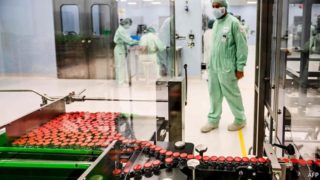The AstraZeneca-Oxford jab is likely to be widely used around the world
IN JANUARY, when most of the world was just becoming aware of covid-19, scientists raced into their laboratories, clutching a freshly minted copy of the genetic code of the coronavirus that causes the disease. In those early days it was almost impossible to imagine that within 11 months three effective vaccines against covid-19 would be created. Yet this is exactly what has come to pass. For the third Monday running, the developers of a vaccine have announced highly encouraging results. On November 23rd researchers at AstraZeneca, a big pharmaceutical company, and Oxford University reported that their vaccine is 70% effective. It comes with a big bonus: it is expected to be cheaper and easier to distribute globally than other vaccines.
The results are estimated from a peek at interim data gathered from trials in Britain and Brazil, involving more than 23,000 volunteers. Like all the vaccines with results so far, AstraZeneca’s was administered in two jabs. Of those given the vaccine, none was hospitalised or even suffered a severe case. The researchers also say that their vaccine may reduce the transmission of the virus—something not yet known about the two other vaccines for which results have been reported, from Pfizer and BioNTech, and Moderna. The ideal vaccine needs to prevent people infecting each other, as well as stop recipients from falling ill.
The trial also included a dosing regime in which some participants were initially given only a half-dose of the vaccine, followed by a full one. The efficacy of this regime reached 90%. Why might a lower initial dose yield a stronger response? The answer may lay in the method that the vaccine uses to deliver genetic material from the coronavirus into the body: in a viral vector—another virus, acting as a sort of envelope.
Before the trials, scientists had worried that the body might develop immunity to the vector as well as to proteins from the coronavirus. The findings hint that anti-vector immunity might be a factor in the regular two-dose regimen. A larger first dose could prime the body to develop antibodies to the vector, thus reducing the efficacy of the second dose. A smaller first dose might get around this problem. The researchers expect to have more information in the weeks ahead that will improve confidence in this result.
As with data on all three vaccines with results so far, much of the information provided is frustratingly (if understandably) preliminary. However, the academics at Oxford say they hope to submit a paper to a journal in the next 24 hours. It is not clear when the teams developing the other two vaccines will do the same.
Both Moderna and the Pfizer-BioNTech partners have said that their vaccines are around 95% effective. Although it is tempting to compare the efficacy of the different vaccines, that is difficult, for a number of reasons. The most important is that developers are counting cases of covid-19 in different ways. The AstraZeneca and Oxford trials checked participants for asymptomatic infections, rather than relying on self-reported symptoms, so the number of cases after vaccinations may appear higher than for Pfizer, which relied on self-reporting by patients (with a follow-up confirmatory test).
Whatever the outcome of more thorough analyses, it is clear that the world has three highly effective vaccines. If approved, AstraZeneca’s can be rolled out fast. It can be produced at many sites around the world, and 3bn doses can be made next year (compared with, say, 1.3bn by Pfizer-BioNTech). Pascal Soriot, head of AstraZeneca, said his firm has partnerships with suppliers in India, Latin America, Russia and Thailand. The Serum Institute, an Indian maker of drugs and vaccines, committed itself to mass-manufacturing the AstraZeneca vaccine as long ago as April. “We are going to supply low- and middle-income countries around the world from different sources,” Mr Soriot says. “We are aiming at doing this more or less at the same time, so everybody gets access in an equitable manner as quickly as possible”.
The vaccine is also cheap and can be kept for at least six months in a normal fridge. The Pfizer vaccine needs ultra-cold storage of -70°C, and can be kept in a fridge for only a few days; the Moderna vaccine can be kept in a fridge for a month. This means that the AstraZeneca vaccine can be stored in any surgery or pharmacy around the world. Richard Hatchett, the head of CEPI, a foundation that funds research into vaccines for pandemics, said he thought this vaccine had the potential to significantly alter the course of the global pandemic and could be delivered anywhere, including poor countries.
Although AstraZeneca says that the vaccine was well tolerated by those who received it, questions remain about an unknown adverse event that caused trials to be temporarily halted earlier this year. Questions such as these must now be considered by regulators, as they assess applications for emergency authorisation that the makers of all three vaccines will submit. AstraZeneca says it will also seek an emergency listing from the World Health Organisation. That will allow its jabs to be used in countries that do not have regulatory authorities capable of assessing vaccines.
If time were not of the essence, it would make sense to wait for longer-term data to be gathered on these new vaccines. But in the face of a pandemic, that is not an option. Regulations to allow for emergency use are designed for situations just like this. However, it does mean that regulators will need to keep tight control of these new vaccines for a while. At the outset their use will probably be restricted to those deemed to need them most, eg, health workers or the elderly; and the regulators will insist on close monitoring for side effects. As data are accumulated, in the first quarter of next year, those chains are likely to be loosened.
By The Economist





